With its sting that inflicts highly toxic stings, the scorpion has become the deadliest venomous animal in Brazil, where rampant urbanization and global warming favor its proliferation.
High temperatures act “on the metabolism of these animals, which are more active, eat and reproduce more,” Thiago Chiariello, coordinator of anti-scorpion serum production at the Butantan Institute in Sao Paulo, explains to AFP.
In his laboratory, hundreds of scorpions are confined in plastic jars or boxes.
Their venom is extracted there to produce this serum distributed in all regions of this immense country of 212 million inhabitants.
More than 200,000 scorpion stings were recorded in Brazil last year, according to the Ministry of Health, 15% more than in 2022.
This represents an average of nearly 550 bites per day.
One of the most widespread venomous species in the country is the yellow scorpion (Tityus serrulatus), composed only of females, which reproduce asexually.
Smaller and better adapted to an urban environment than snakes, scorpions have overtaken them in the ranking of venomous animals having caused the most deaths in Latin America’s largest country.
In 2019, snake bites killed 155 people in Brazil, compared to 95 for scorpions, according to data from the Health Ministry.
The ranking reversed in 2023, with scorpions causing 152 deaths, 12 more than snakes.
Predators on the run
“They are distributed over larger areas,” says Paulo Goldoni, biologist at the Butantan Institute.
Contrary to what is observed in other animals, the proliferation of scorpions, some species of which are harmless, is favored by urban expansion, which scares away their main predators.
“In nature, certain birds, lizards and toads eat scorpions, but they do not come near cities,” underlines Thiago Chiariello.
Not to mention that cockroaches, the favorite food of these arachnids, swarm in the heat of urban spaces in Brazil.
“We must take precautions, such as avoiding leaving garbage lying around,” warns Mr. Chiariello.
His team is responsible for an extremely precise mission: using tweezers to direct the scorpion’s sting towards a small container where the venom is collected.
This venom is “injected into horses” which are more resistant and produce more antibodies than human beings.
“Then there is a whole work of purifying the horse’s blood to obtain the final product, the serum,” describes Paulo Goldoni.
Photo AFP
“Save lives”
“The serum is the only way to save lives,” notes this biologist, specifying that the sting of the yellow scorpion can be fatal for the elderly or children weighing less than 20 kg.
In 2023, more than 11,000 people received a dose of anti-scorpion serum in Brazil, most of them in the densely populated regions of the Southeast, according to authorities.
Scorpion venom contains an “exorbitant amount” of toxic elements, which can cause “an increase in blood pressure and heart or lung problems,” warns Mr. Goldoni.
New specimens of scorpions are constantly brought to the institute to meet the growing demand for serum.
“In the event of a shortage of serum, the number of deaths would certainly have been much higher,” warns the biologist.







